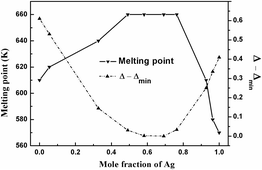Melting phenomena: effect of composition for 55-atom Ag–Pd bimetallic clusters
Abstract
Understanding the composition effect on the melting processes of bimetallic clusters is important for their applications. Here, we report the relationship between the melting point and the metal composition for the 55-atom icosahedral Ag–Pd bimetallic clusters by canonical Monte Carlo simulations, using the second-moment approximation of the tight-binding potentials (TB-SMA) for the metal–metal interactions. Abnormal melting phenomena for the systems of interest are found. Our simulation results reveal that the dependence of the melting point on the composition is not a monotonic change, but experiences three different stages. The melting temperatures of the Ag–Pd bimetallic clusters increase monotonically with the concentration of the Ag atoms first. Then, they reach a plateau presenting almost a constant value. Finally, they decrease sharply at a specific composition. The main reason for this change can be explained in terms of the relative stability of the Ag–Pd bimetallic clusters at different compositions. The results suggest that the more stable the cluster, the higher the melting point for the 55-atom icosahedral Ag–Pd bimetallic clusters at different compositions.


 Please wait while we load your content...
Please wait while we load your content...